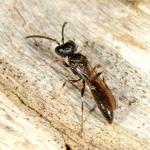Passaloecus gertrudis KROMBEIN 1938; Passaloecus gracilis MISIDENT.; Passaloecus tenuis MORAWITZ 1864
Probably the most common British species of Passaloecus, at least in the south.
Mainly an English species, with a few records from east Wales.
A common species throughout Europe, and found eastwards through Asia to Japan (Lomholdt 1975-76).
This species is not regarded as being scarce or threatened.
A generalist, found in many habitats including gardens.
May be reared from stems as early as April; has been captured on the wing from mid-May to early September, and particularly during June. Richards (1980) commented that the species is less common from July onwards.
The prey are wingless aphids (Homoptera, Aphididae) (Lomholdt 1975-76).
Nests are prepared by females in pithy stems or abandoned beetle borings in wood, such as fence posts. Also used are old Lipara lucens galls on common reed stems. The cells are separated by partitions of resin and a final closure is effected with a mixture of resin and small stones, 0.5 to 1 mm diameter (Lomholdt 1975-76), which is distinctive of the species.
No information is available on flower visits but the species may preferentially visit honeydew.
A variety of hymenopterous parasitoids/cleptoparasites have been recorded on the continent, including Ichneumonidae (Perithous mediator and P. divinator), Eurytomidae (Eurytoma sp.) and Chrysididae (Pseudomalus auratus and Trichrysis cyanea) (Lomholdt 1975-76).
2002


